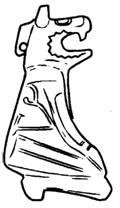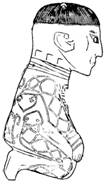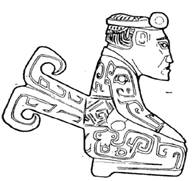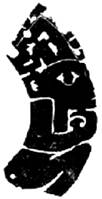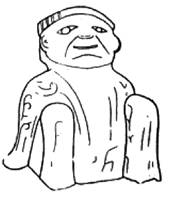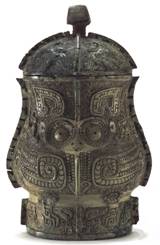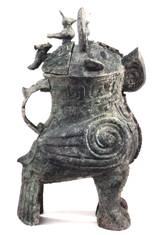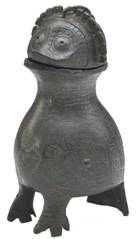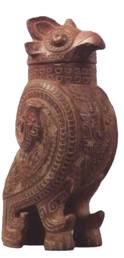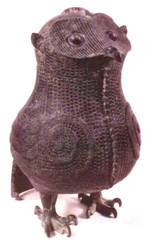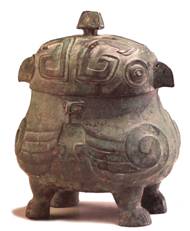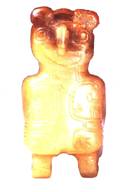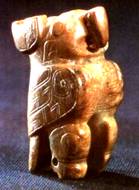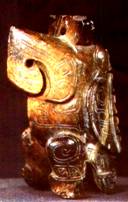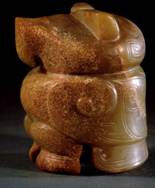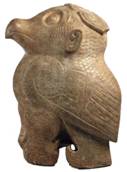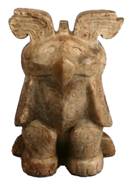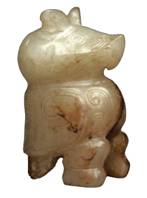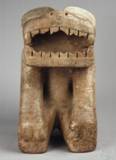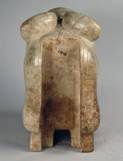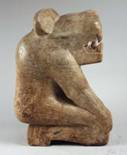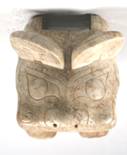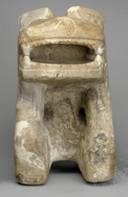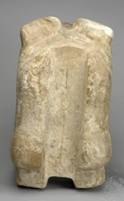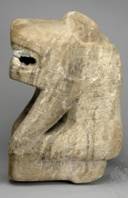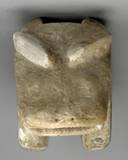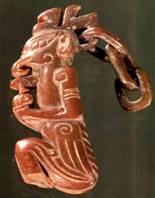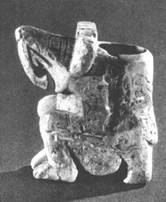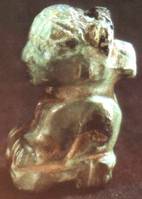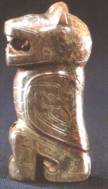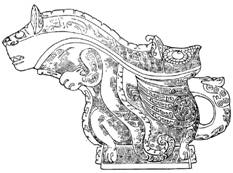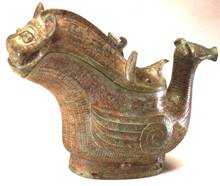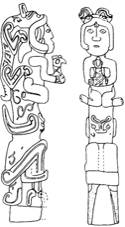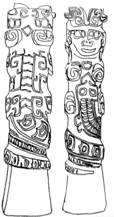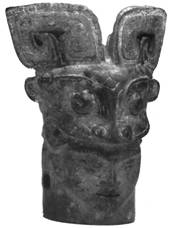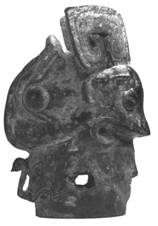
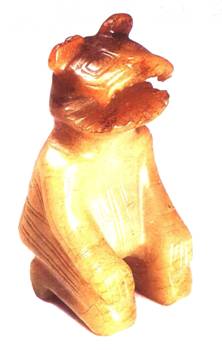
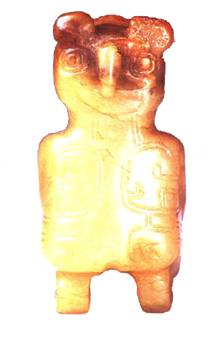
Tiger-shaped kneeling Tiger-shaped kneeling
jade figurine, profile jade figurine, back
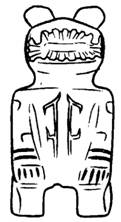
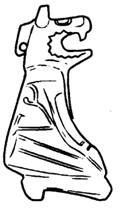
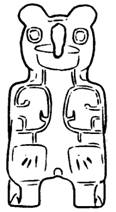
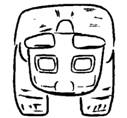
front side back top view
Fig. 1 Tiger-shaped kneeling jade figurine (contour drawing)
The tiger-shaped kneeling jade figurine, round sculpture, features greenish yellow color, with some brown spots and slightly mixed color on the top. The front and back of the figurine show different images (Fig.1)
The front of the figurine features a tiger head and a human body. The tiger head is held high with a wide open mouth, two long and round eyes and a pair of semi-circular ears. The clothed human body leans forward and kneels on the ground with two hands on the knees. The back of the figurine is carved into the shape of an owl. The two tiger ears are made the ears of the owl with one round hole under its beak. The back of the human figure is made the body, the arms of the human, the wings, and the feet of the human, the feet of the owl.
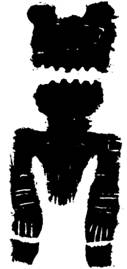
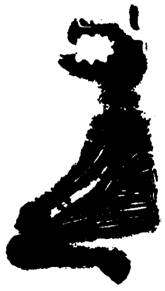
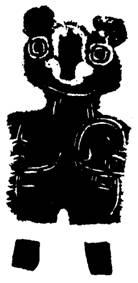
front side back
Fig.2 Rubbings of the tiger-shaped kneeling jade figurine
1. Kneeling
The tiger-shaped kneeling jade figurine is carved into a Jizuo (kneel and sit) position, also known as Guizuo. According to the interpretation of the character Ju in Shuowenjiezi Duanzhu (Notes to the Analytical Dictionary of Characters): “Ancient people distinguished between Zuo (sit), Gui (kneel), Dun (squat), and Jiju (sit on the floor with one’s legs stretched out). To kneel or sit, one should kneel on the floor. One should straighten up his body to kneel and lower his bottom to sit … To squat, one should put his feet on the ground and lower his bottom and curve his knees… To Jiju, one should put his bottom on the floor and stretch out his legs in front of him.”
The three round-sculptured jade figurines unearthed from Fu Hao’s Tomb were representative of kneeling jade figurines in the Shang Dynasty. Most of the jade figurines in relief including those unearthed from Fu Hao’s Tomb and from the tomb in Xibeigang of Houjiazhuang village were in squatting position. In addition, the stone figurines of the Shang Dynasty unearthed from Sipanmo of Anyang were in Jiju position.
|
|
|
|
|
| Tiger-shaped kneeling jade figurine unearthed from Changzikou Tomb |
The capped kneeling stone human figurine unearthed from Fu Hao’s Tomb |
Kneeling jade human figurine with snake pattern unearthed from Fu Hao’s Tomb |
Kneeling jade human figurine with T-shaped ornament on the waist unearthed from Fu Hao’s Tomb |
|
|
|
|
|
| Squatting jade human figurine unearthed from Fu Hao’s Tomb |
Squatting jade human figurine unearthed from Fu Hao’s Tomb |
Squatting jade human figurine unearthed from Houjiazhuang Tomb |
Stone human figurine in Jiju position unearthed from Sipanmo of Anyang |
| Fig. 3 Sitting positions of jade human figurines of the Shang Dynasty |
|||
By analyzing the ancient characters inscribed on bones or tortoise shells, Mr. Li Ji classified the occasions when kneeling occurred into four categories (Fig. 4): “related to female; a symbol of conquering; related to offering sacrifices to ghosts and deities; and related to food and beverage.” It showed that in the Shang Dynasty, kneeling was required on occasions when social hierarchy was strictly observed, especially in sacrificial ceremonies.
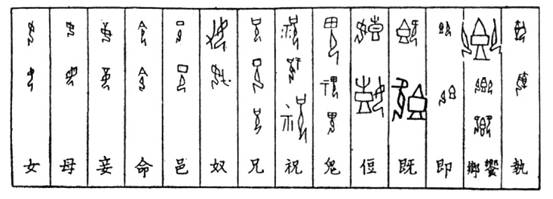
Fig. 4 Kneeling images in the ancient characters inscribed on bones or tortoise shells
2. Standing owl
The images of owl on the bronze wares of the Shang Dynasty (Fig. 5). In some cases, the owl pattern was carved on the bronze wares such as the Zhi (drinking vessel) with owl pattern. Others were cast into the shape of owl such as the owl-shaped Zun (vase) unearthed from Fu Hao’s Tomb and different sorts of owl-shaped Zuns in the collection of the Freer Gallery of Art, Cleveland Museum of Art, and Minneapolis Institute of Art in the United States. Another example was the owl-shaped You (a wine drinking vessel) unearthed from Shilou, Shanxi Province.
|
|
|
|
| Zhi with owl pattern in the collection of the Asian Art Museum of San Francisco |
Owl-shaped Zun unearthed from Fu Hao’s Tomb |
Owl-shaped Zun in the collection of Freer Gallery of Art |
|
|
|
|
| Owl-shaped Zun in the collection of the Cleveland Museum of Art |
Owl-shaped Zun in the collection of the Minneapolis Institute of Arts |
Owl-shaped You unearthed from Shilou, Shanxi Province |
| Fig. 5 The images of owl on the bronze wares of the Shang Dynasty |
||
Various round-sculptured jade owls of the Shang Dynasty (Fig.6) have been unearthed including the six pieces from Fu Hao’s Tomb, two pieces from Houjiazhuang and those from Maoxi Township of Xi’an and the one in the collection of the Museum of Xinxiang.
|
|
|
|
|
| The tiger-shaped kneeling jade figurine, back |
Jade owl unearthed from Fu Hao’s Tomb, Xiaotun M5: 465 |
Jade owl unearthed from Fu Hao’s Tomb, Xiaotun M5: 507 |
Jade owl unearthed from Fu Hao’s Tomb, Xiaotun M5: 513 |
|
|
|
|
|
| Stone owl unearthed from Houjiazhuang, M1001: R001610 |
Stone owl unearthed from Houjiazhuang, M1001, R001756 |
Jade owl unearthed from Maoxi Township, Xi’an |
Jade owl in the collection of the Museum of Xinxiang |
| Fig.6 The jade owls of the Shang Dynasty |
|||
The large number of owl images in the Shang Dynasty that attached great importance to worshipping ghosts and deities are believed to be related to religious beliefs. According to Liu Dunyuan, owls symbolized the Deity of Night and Deity of Dream. Huang Houming believed that owls were nocturnal birds that carried the souls of ancestors, and were therefore the personifications of ancestors. Ye Shuxian argued that Xuan in the term of Xuanniao (Xuan Bird) originally meant “rotation”, coinciding with the character of owls that could turn their heads and eyes in large angles, thus Xuanniao was the same bird as owl. According to Sun Xinzhou, the Xuanniao in the phrase “By God’s will, Xuanniao landed to give birth to the Shang Dynasty” was owl. The demonization of owls had not started until the Western Zhou Dynasty. In the Shang Dynasty, however, owls had been viewed as a symbol of holiness and played a critical role in the belief system.
The tiger-shaped kneeling jade figurine can be dissected into three parts: human-tiger combination, human-owl combination and tiger-owl combination.
1.Combination of human and tiger
The human-tiger combination features a tiger head and a human body. Two marble sculptures with a tiger head and a human body were unearthed from Houjiazhuang. The stone figurine from M1001 (Fig.7) featured a “tiger head and human body kneeling on the floor with two hands on the knees. The tiger head was slightly held up with two pricking ears. Its eyes, nose and strips on its body were carved in intaglio in a powerful manner.” The tiger-headed and human-bodied marble sculpture of M1550 was similar to the one of M1001. The groove on the back might be used for inserting wooden sticks.
|
|
|
|
|
| Stone sculpture with a tiger head and a human body unearthed from M1001 at the Yin Ruins |
|||
|
|
|
|
|
| Stone sculpture with a tiger head and a human body unearthed from M1550 at the Yin Ruins |
|||
| Fig. 7 Marble sculpture with a tiger head and a human body unearthed from Houjiazhuang of Anyang |
|||
On the stone sculpture of M1001, two lines of Kui-dragon patterns were carved on the arms and two snake patterns on the side of the figurine. According to Classic of the Great Wilderness: Northfrom the Classic of the Mountains and Seas: “There used to be a god who devoured snakes in his mouth and manipulated snakes with his hands. He had a tiger head and a human body with four hoofs and long arms, and was called Jiangliang.” Both Jiangliang and the stone sculpture had tiger heads and human bodies. Besides, the snakes devoured by Jiangliang corresponded with the Kui-dragon patterns and snake patterns on the arms and around the waist of the stone figurine. Therefore, some scholars believed that the tiger-headed and human-bodied images of the Shang Dynasty were a reflection of Jiangliang in the Classic of the Mountains and Seas.
2. Combination of human and bird
Such a combination in the Shang Dynasty was often reflected in the images of “a bird head and a human body”, which were discovered from the tombs of Shang Dynasty in Xin’gan and Fu Hao’s Tomb. The Gong (a wine vessel) with bird and beast design collected by the Freer Gallery of Art featured an owl-shaped handle with human feet. There were snakes coiling around the legs of the owl, which symbolized the design of “trampling on snakes”. It was likely that this image was a reflection of a shamanist who wore a mask in the shape of a bird head while practicing magic.
|
|
|
|
|
| Jade sculpture with a bird head and a human body unearthed from the tomb of the Shang Dynasty in Xin’gan |
Jade sculpture with a bird body and human feet unearthed from Fu Hao’s Tomb |
The handle of a Gong vessel with bird and beast design in the collection of the Freer Gallery of Art |
Jade figurine in the shape of a combined bird and human unearthed from Fu Hao’s Tomb |
| Fig. 8 Images of combined bird and human in the Shang Dynasty |
|||
According to the report, the round-sculptured malachite human figurine unearthed from Fu Hao’s Tomb (Fig.8, right) had “a saggy chignon on the back of the head (of the human figurine) … and a semi-circular hair ornament carved above the chignon.” By comparing it with the tiger-shaped kneeling jade figurine, we can know that the “saggy chignon” was in fact the beak of an owl and the “semi-circular hair ornament” was ears of the owl. This must be a kneeling figurine wearing an owl-shaped mask in the back of the head.
3. Combination of tiger and owl
Tiger and owl usually appeared in pairs in the art of the Shang Dynasty (Fig.9): The jade sculpture with a tiger head and a bird body unearthed from Fu Hao’s Tomb, the image of tiger and owl on the Gong vessel with a ring foot, and the ![]() Gong vessel in the shape of a combined tiger and bird in the collection of the Freer Gallery of Art.
Gong vessel in the shape of a combined tiger and bird in the collection of the Freer Gallery of Art.
|
|
|
|
| Jade sculpture with a tiger head and a bird body Xiaotun M5:990 |
“Fu Hao” Gong vessel with a ring foot Xiaotun M5: 802 |
Gong vessel in the shape of a combined tiger and bird In the collection of the Freer Gallery of Art |
| Fig. 9 Images of “combined tiger and owl” of the Shang Dynasty |
||
4. Interpretation of the human, tiger and owl combination
How should we understand the relationship between the human, tiger and owl images in the tiger-shaped kneeling jade figurine? I think both the tiger and owl were features of masks worn by the shamanists in the Shang Dynasty, which represented the animals that assisted the shamanists in practicing magic.
Two sculptures from the Western Zhou Dynasty (Fig. 10, 1 & 2 from the left) provide support to my point of view. One was the pole-end ornament in the shape of a human figurine covered by a tiger skin with birds in his hands, now in the collection of the British Museum. Another one was the bone sculpture now in the collection of the Minneapolis Institute of Arts that featured a human figurine covered in tiger skin with snake in his hands. These similar designs indicate that the human figurines were of the same profession and represent the shamanists practicing magic. The tiger skin worn by them was the main feature when they were practicing magic, and the birds or snakes were tools and assistants that could help them communicate with the deities.
|
|
|
|
|
| Pole-end ornament of the Western Zhou Dynasty in the collection of the British Museum |
Bone sculpture of the mid Western Zhou Dynasty featuring design of tiger, snake and deity in the collection of the Minneapolis Institute of Arts |
Ornament on chariot canopy staff in the shape of a man wearing a beast-headed mask (front), London Sotheby’s. |
Ornament on chariot canopy staff in the shape of a man wearing a beast-headed mask (side), London Sotheby’s |
| Fig.10 Accessories for shamanists when practicing magic in the Shang and Zhou Dynasties |
|||
The image of a human body with a tiger head was a reflection of a shamanist practicing magic under tiger skin, which was sometimes replaced by a tiger-shaped mask, for example, the chariot canopy ornament in the shape of a man wearing a beast-headed mask now in the collection of the Sotheby’s in London (Fig.10, 3 from the left). Then how should we understand the image of owl behind the tiger head? From the sides of the mask (Fig. 10, 1st from the right), we can see patterns of other two beasts carved behind the tiger head, which indicated that there were attempts to integrate the several kinds of masks often worn by shamanists in the art of the Shang and Zhou Dynasties. A conclusion can be drawn by comparing the tiger-shaped kneeling jade figurine with the chariot canopy ornament in the shape of a man wearing a beast-headed mask that the former represented the magic-practicing shamanist wearing a mask in the shape of a tiger head (symbolizing a shamanist under tiger skin). Meanwhile, as shamanists also wore owl-shaped masks, the attempt to combine both images created the trinity of human, tiger and owl as was in the tiger-shaped kneeling jade figurine. Another possibility was that the owl in the tiger-shaped kneeling jade figurine was a symbolic image that the shamanist used to communicate with the deity. The owl, under such a circumstance, functioned as an assistant to the shamanist in magic practicing just like the bird in hands of the person on the pole-end ornament
How should we interpret the meaning of the large number of combined images of human and beast discovered in the art of the Shang Dynasty?
Your answer please, if you have any questions or answer, please feel free to send us email, we are waiting for your answers and participation, and your comments, answers and suggestions will be highly appreciated. We will select and publicize the most appropriate answers and comments some time in the future.
Weekly Selection Email: meizhouyipin@chnmus.net
The Changzikou Tomb in Taiqinggong of Luyi
It dates back to the early Western Zhou Dynasty. The owner of the tomb lived in a period that spanned across the Shang and Zhou Dynasties. The tomb had remains of the Shang Dynasty and the Dongyi clan. With a plan shaped like the Chinese character of Zhong (“中”), it features one passage in the north and south respectively. The burial chamber in the shape of the Chinese character Ya (“亚”) had sacrifices of 14 people, five horses and one dog. A total of nearly 2,000 pottery, bronze, jade, bone, shell and ivory carved objects were unearthed. Out of the bronze wares unearthed, 54 bore inscriptions and 39 had the inscription of three Chinese characters Changzikou (“长子口” ). Chang was the name of a clan or state. Zi symbolized the identity and Kou was a private name.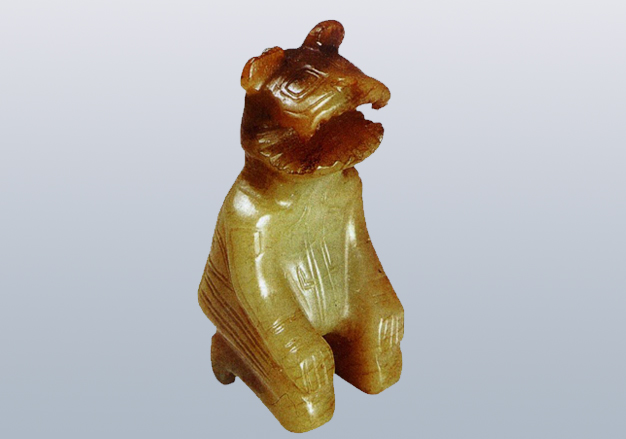
The Kneeling Human Figure with Tiger's Head, or tiger-shaped kneeling figurine, a piece of jade ware dating from the late Shang and early Zhou Dynasty, measures 5 cm in height, 2.5 cm in width and 2.8 cm in thickness, and was unearthed from the Changzikou Tomb of Taiqinggong in Luyi in 1997.
